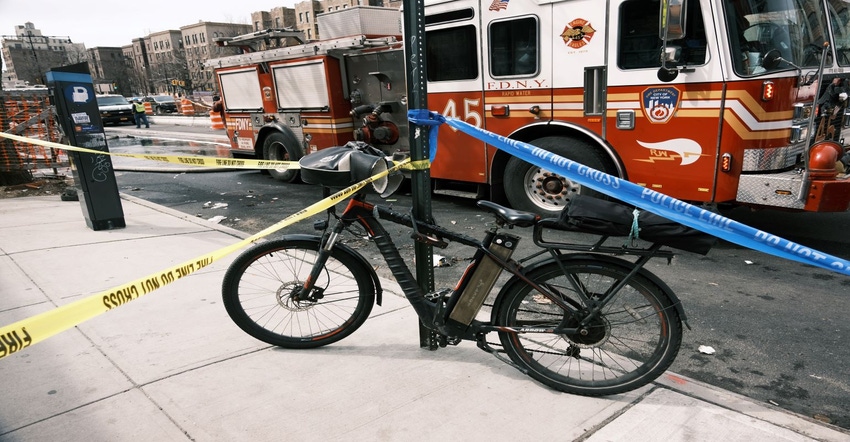E-Bike Fires Prompt More Regulations and Call for Safer Design
Major cities are imposing stricter regulations while industry awaits emergence of safer e-bikes.

E-bikes have exploded in popularity in recent years as a low-cost, clean energy form of transportation. Unfortunately, safety concerns due mostly to the vehicles catching on fire due to overheated batteries have become all too common.
The problem has become particularly acute in urban areas such as New York City, where it has become all too common to hear about a building fire caused by an e-bike that whose batteries overhead due to improper storage and charging.
Experts acknowledge that much of the problem can be attributed to low-cost bikes, often imported from overseas, that were sold online before any safety regulations were passed. These bikes often used batteries of low-quality materials. Exacerbating this issue were efforts by some consumers to replace the batteries using low-quality cells.
Moving to Higher Quality
E-bike expert Bill Klehm is Chairman and CEO of eBliss, a developer of e-mobility transportation solutions including e-bikes. Klehm, whose long experience in e-bikes includes overseeing the development of the NuVinci continuously variable transmission, believes a fundamental shift in the market towards higher quality products will weed out the cheaper, unregulated products.
“The biggest issue is inexpensive batteries and materials,” said Klehm. “We saw the same issue in laptop computers,” referring to the problem of lithium-ion batteries in laptop computers overheating and catching fire. Klehm asserts that many of the e-bikes with the problematic lithium batteries are not new products but came out years ago and are not sold by reputable e-bike dealers, instead often sold online.
“Reputable e-bike makers will not sell a high-risk product,” Klehm said. His company is developing a line of higher-end e-bikes with features such as belt drives and sealed drivetrains, which are rigorously tested and meet the latest e-bike safety standards.
“An e-bike costing under $1,000 will not be of high quality and lack safety features,” Klehm said. Drawing from previous experience in the automotive industry, Klehm noted that one of the main costs of any vehicle is testing and validating safety and reliability.
Rapid e-bike Growth
Moving the e-bike market towards higher quality products will have positive effects in the years ahead, but pure growth in the e-bike market has already created a proliferation in the quantity of products available.
A Grandview Research study said the global e-bikes market size was valued at $17.83 billion in 2021 and is expected to expand at a compound annual growth rate (CAGR) of 13.5% from 2022 to 2030. In the U.S., the market will grow even faster, at a CAGR of 22.6%
The sheer proliferation of e-bikes has multiplied the number of devices potentially prone to battery failure. While lead-acid is still used in many e-bike batteries, lithium-ion is fast becoming the preferred technology because of its lighter weight and higher energy density.
But those advantages come with a cost. Thermal runaway conditions can result if batteries are not charged or stored properly. Overcharging the battery, excessive discharge, exposing the battery to high temperatures (-40 to +70◦C is considered optimal), and physical damage to the battery are some of the conditions that could lead to thermal runaway. The dangers are far worse with lithium-ion because of its higher energy density than with sealed lead-acid.
The proliferation of fires has prompted UL (Underwriters Laboratories to take action. In 2016, UL created the 2272 standard relating to the safety of e-mobility devices. That standard came about primarily due to a spate of fires with overheated lithium batteries in electric hoverboards, but does include e-bikes as one of several personal e-mobility devices with potential lithium-ion battery issues
In 2020, UL published the 2849 standard, which relates specifically to e-bikes. This standard spells more specifically spells out the requirements for the device’s battery management system in addressing issues such as overheating.
Fire departments and agencies, such as the National Fire Protection Association (NPFA), have warned about e-bike battery safety and published videos on safe charging and storage. However, the problem has continued to proliferate, particularly in crowded urban areas such as New York City. In these locations, the e-bike buyers tend to buy lower-priced models that may have been built and sold prior to safety regulations. Exacerbating the issue is lack of adequate facilities to safely store e-bikes, which force consumers to store them in apartments with limited space and outdated electrical systems.
In addition, many businesses in New York and other dense urban areas rely on e-bike delivery services, only adding to the sheer proliferation of e-bikes. The bikes used in delivery functions tend to take a heap of abuse from constant use, only adding to the risk of damage and potential danger.
Restrictions Coming
Hope may be coming, however. The New York City Council recently voted on a legislative package that would restrict the sale of e-bikes and their storage batteries to meet UL standards. The e-bikes would be required to display the testing lab logo on the product package or documentation.
The legislation would also restrict the assembly and reconditioning of lithium-ion batteries with their cells moved from used batteries, as well as their commercial sale. This would prevent consumers from using off-brand replacement batteries that fail to meet UL standards.
The legislation also calls for development and distribution of educational materials on e-bike safety risks and mitigation measures for delivery workers, a prime market for e-bike sales.
The New York City legislation could put a severe crimp in the sales of lower cost e-bikes and could meet with resistance from some smaller businesses which cannot afford to outfit their workers with costlier bikes. But such legislation is applauded by e-bike industry veterans such as Bill Klehm of e-Bliss, who sees the industry maturing as a result of restricting the number of off-brand bikes.
“Europe has imposed tariffs on e-bikes from China,” said Bill Klehm of e-Bliss. “This is an opportunity for governments to create additional standards.”
Spencer Chin is a Senior Editor for Design News covering the electronics beat. He has many years of experience covering developments in components, semiconductors, subsystems, power, and other facets of electronics from both a business/supply-chain and technology perspective. He can be reached at [email protected].
About the Author(s)
You May Also Like





